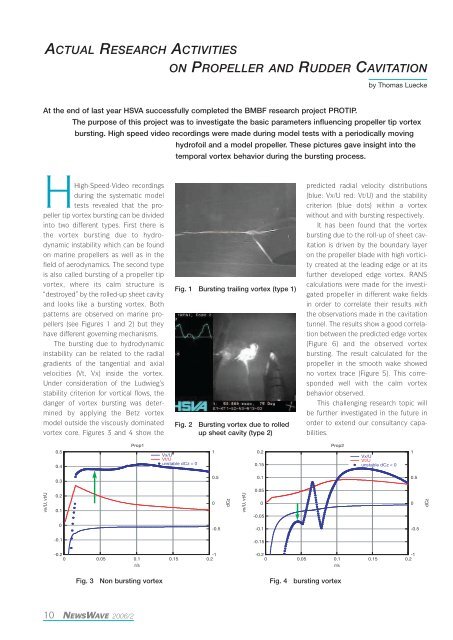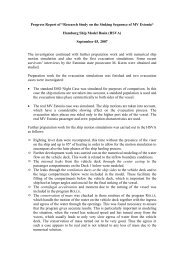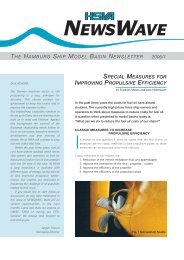Create successful ePaper yourself
Turn your PDF publications into a flip-book with our unique Google optimized e-Paper software.
ACTUAL RESEARCH ACTIVITIES<br />
ON PROPELLER AND RUDDER CAVITATION<br />
HHigh-Speed-Video recordings<br />
during the systematic model<br />
tests revealed that the propeller<br />
tip vortex bursting can be divided<br />
into two different types. First there is<br />
the vortex bursting due to hydrodynamic<br />
instability which can be found<br />
on marine propellers as well as in the<br />
field of aerodynamics. The second type<br />
is also called bursting of a propeller tip<br />
vortex, where its calm structure is<br />
“destroyed” by the rolled-up sheet cavity<br />
and looks like a bursting vortex. Both<br />
patterns are observed on marine propellers<br />
(see Figures 1 and 2) but they<br />
have different governing mechanisms.<br />
The bursting due to hydrodynamic<br />
instability can be related to the radial<br />
gradients of the tangential and axial<br />
velocities (Vt, Vx) inside the vortex.<br />
Under consideration of the Ludwieg’s<br />
stability criterion for vortical flows, the<br />
danger of vortex bursting was determined<br />
by applying the Betz vortex<br />
model outside the viscously dominated<br />
vortex core. Figures 3 and 4 show the<br />
10 <strong>NEWSWAVE</strong> 2006/2<br />
by Thomas Luecke<br />
At the end of last year <strong>HSVA</strong> successfully completed the BMBF research project PROTIP.<br />
The purpose of this project was to investigate the basic parameters influencing propeller tip vortex<br />
bursting. High speed video recordings were made during model tests with a periodically moving<br />
hydrofoil and a model propeller. These pictures gave insight into the<br />
temporal vortex behavior during the bursting process.<br />
Fig. 1 Bursting trailing vortex (type 1)<br />
Fig. 2 Bursting vortex due to rolled<br />
up sheet cavity (type 2)<br />
Fig. 3 Non bursting vortex Fig. 4 bursting vortex<br />
predicted radial velocity distributions<br />
(blue: Vx/U red: Vt/U) and the stability<br />
criterion (blue dots) within a vortex<br />
without and with bursting respectively.<br />
It has been found that the vortex<br />
bursting due to the roll-up of sheet cavitation<br />
is driven by the boundary layer<br />
on the propeller blade with high vorticity<br />
created at the leading edge or at its<br />
further developed edge vortex. RANS<br />
calculations were made for the investigated<br />
propeller in different wake fields<br />
in order to correlate their results with<br />
the observations made in the cavitation<br />
tunnel. The results show a good correlation<br />
between the predicted edge vortex<br />
(Figure 6) and the observed vortex<br />
bursting. The result calculated for the<br />
propeller in the smooth wake showed<br />
no vortex trace (Figure 5). This corresponded<br />
well with the calm vortex<br />
behavior observed.<br />
This challenging research topic will<br />
be further investigated in the future in<br />
order to extend our consultancy capabilities.





